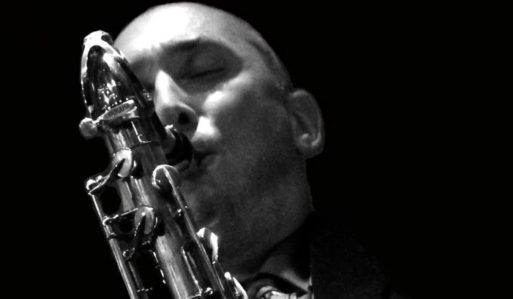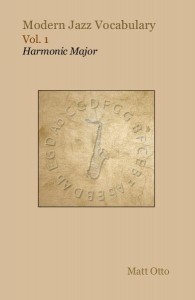This is a simple melody that uses the 2nd mode of harmonic major over a -7b5 chord (or half diminished) in one key (concert F#-7b5) which is concert E harmonic major, the 2nd mode being concert F#-7b5(nat9, nat13).
This 2nd mode of harmonic major creates an interesting “bright” sound over half diminished; natural 9 and natural 13.
The more common locrian mode of the major scale gives you a b9 and b13 on a -7b5 and the popular 6 mode of melodic minor will give you a natural 9 and a b13 over a -7b5.
The 2nd mode of harmonic minor over -7b5 will give you the b9 and the natural 13.
All 4 scales will work nicely over a half diminished chord but this melody just focuses on using the natural 9 and natural 13 sound (2nd mode of harmonic major).
Here’s a simple chart that should help make it clear:
F#-7b5 (b9,b13) = F# locian (G maj scale 7th mode) F#, G, A, B, C, D, E, F#
F#-7b5(nat9,b13) = 6 mode of A melodic min F#, G#, A, B, C, D, E, F#
F#-7b5(b9, nat13) = 2nd mode of E harmonic min F#, G, A, B, C, D#, E, F#
F#-7b5(nat9,nat13) = 2nd mode of E harmonic maj F#, G#, A, B, C, D#, E, F#
The intro and outro clips in the video are short improvisations using this 2nd mode of harmonic major i.e. concert E harmonic major, 2nd mode = F#-7b5(nat9, nat13).
The short melody in the lesson uses a grouping of 7/8 over 4/4 and is a sequential melody descending by diatonic 3rds through the mode (cycle 6 in Mick Goodrick’s system).
Try singing the melody over a drone or the F#-7b5 chord until it feels comfortable than play idea on your instrument. After try improvising freely with the mode.
For more an introduction on the use of the 7 modes of harmonic major, you can pick up my book on the topic here.
~Enjoy!
.
Lesson 68: -7b5(nat 9,nat 13) PDF
.

